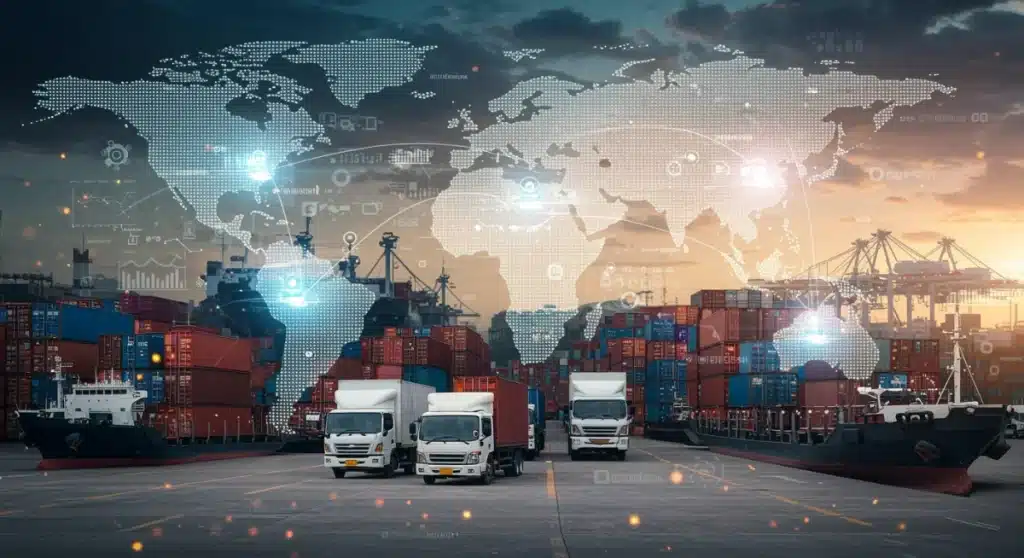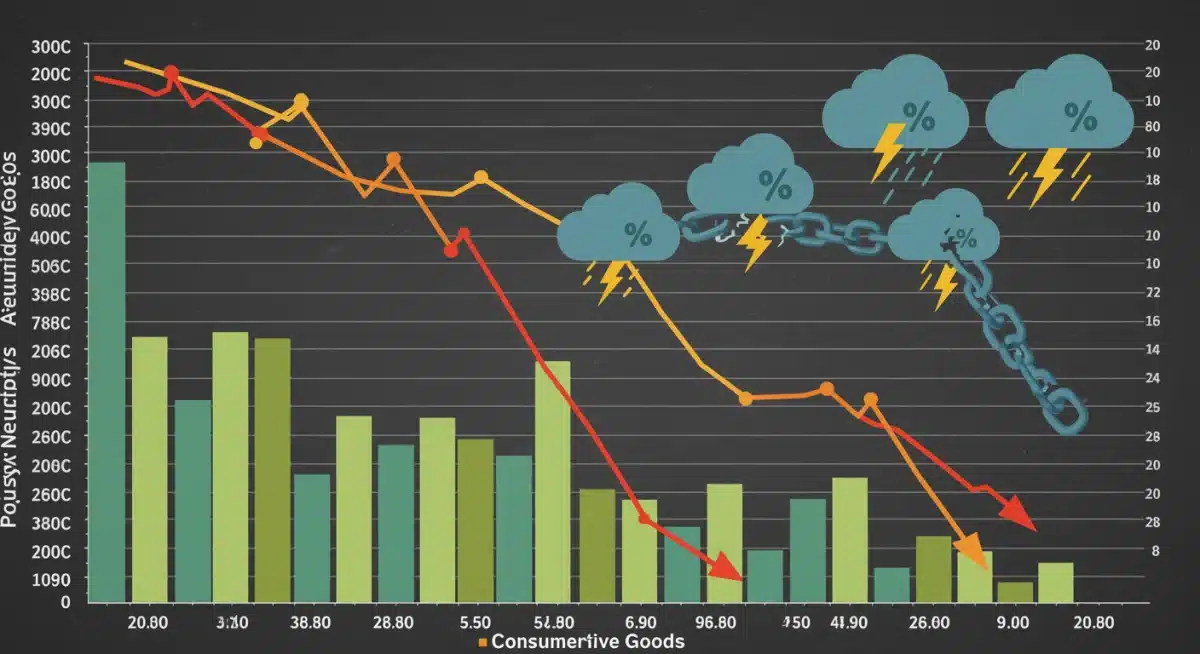Global Supply Chains in 2025: Vulnerabilities & 8% US Impact

As 2025 approaches, the stability of our interconnected world hinges significantly on the robustness of its logistical arteries. The intricate web of global supply chains in 2025: 3 critical vulnerabilities and their potential 8% impact on US consumer goods demands immediate attention. Understanding these impending challenges is crucial for businesses and consumers alike.
Geopolitical Instability: A Lingering Threat
Geopolitical tensions continue to be a primary concern for the resilience of global supply chains. As of recent analyses, several flashpoints globally pose direct risks to trade routes, resource availability, and manufacturing hubs. The ripple effects of regional conflicts or diplomatic breakdowns can quickly escalate into widespread disruptions, impacting the timely delivery of essential components and finished goods.
Experts from various think tanks have highlighted the increasing frequency and unpredictability of these events. The interconnected nature of modern economies means that even localized disturbances can have disproportionate global consequences, challenging the traditional models of supply chain risk management.
Blocked Trade Routes and Port Congestion
One direct consequence of geopolitical instability is the potential for blockages in critical maritime and overland trade routes. Recent incidents in key shipping lanes have demonstrated how quickly such disruptions can lead to significant delays and increased shipping costs.
- Suez Canal Incidents: Past events showed the vulnerability of narrow passages.
- Red Sea Security: Ongoing threats in this vital corridor continue to reroute traffic.
- Border Closures: Political disputes can lead to sudden closure of land borders, stalling freight.
Resource Nationalism and Trade Wars
Another facet of geopolitical risk is the rise of resource nationalism, where nations prioritize domestic needs over international trade, potentially restricting exports of critical raw materials. Coupled with the possibility of new trade wars, this can create an environment of uncertainty for global manufacturers.
The imposition of tariffs and trade barriers can significantly alter sourcing strategies and increase the cost of imported goods, directly affecting consumer prices in markets like the US. Businesses are already exploring diversification strategies to mitigate these risks, but the pace of change often outstrips reactive measures.
Climate Change and Extreme Weather Events
The escalating impact of climate change is no longer a distant threat but a present reality actively reshaping global supply chains. Extreme weather events are becoming more frequent and severe, causing physical damage to infrastructure, disrupting transportation networks, and affecting agricultural output. This directly translates to significant delays and increased costs across various sectors.
From devastating floods to unprecedented droughts, these events have a cascading effect, from raw material extraction to final product delivery. The unpredictability of these occurrences makes planning and forecasting incredibly challenging for logistics and procurement professionals worldwide.
Disruption to Agricultural Supply
Agriculture, a foundational component of many supply chains, is particularly vulnerable to climate shifts. Prolonged droughts can decimate harvests, leading to shortages and price spikes for food and other agricultural commodities. Conversely, excessive rainfall and flooding can destroy crops and prevent timely harvesting.
- Crop Failures: Reduced yields due to extreme heat or lack of water.
- Harvest Delays: Inaccessible fields or damaged infrastructure hindering collection.
- Pest Infestations: Changing climate patterns can lead to new pest migrations, affecting crop health.
Infrastructure Damage and Logistical Bottlenecks
Beyond agricultural impacts, severe weather directly threatens critical transportation and manufacturing infrastructure. Ports, roads, railways, and factories are all susceptible to damage from hurricanes, floods, and wildfires. When these vital links are compromised, goods cannot move efficiently, creating significant bottlenecks.
Repairing damaged infrastructure is both costly and time-consuming, leading to extended periods of disruption. Companies must invest in more resilient infrastructure and develop robust contingency plans to reroute goods and maintain operational continuity in the face of these growing environmental challenges.
Cybersecurity Threats and Digital Vulnerabilities
In an increasingly digitized world, cyberattacks represent a rapidly evolving and potent threat to global supply chains. Modern logistics rely heavily on interconnected IT systems, from inventory management to shipping tracking. A successful cyberattack can paralyze operations, compromise sensitive data, and erode trust throughout the entire network.
The sophistication of these attacks is growing, with state-sponsored actors and organized crime groups targeting critical infrastructure. The potential for widespread disruption from a single breach can be immense, impacting not just one company but an entire ecosystem of suppliers and customers.
Ransomware and Data Breaches
Ransomware attacks, where malicious software encrypts data and demands payment for its release, have become a disturbingly common occurrence. Such attacks can halt production lines, disrupt distribution, and lead to significant financial losses. Data breaches, meanwhile, can expose proprietary information and customer data, leading to reputational damage and legal repercussions.
The cost of recovering from these incidents extends beyond the ransom payment, encompassing downtime, forensic investigations, and system upgrades. Companies are now forced to invest heavily in advanced cybersecurity measures and employee training to counter these persistent threats.
System Interdependencies and Cascading Failures
One of the most concerning aspects of digital vulnerabilities is the intricate web of system interdependencies within supply chains. A cyberattack on one provider, such as a major logistics software company or a port operator, can have a cascading effect, disrupting numerous businesses that rely on their services. This is not just theoretical; we’ve seen examples of this in recent years.
This interconnectedness means that even small vulnerabilities can be exploited to create large-scale chaos. Building resilience requires not only securing one’s own systems but also ensuring that partners and suppliers adhere to stringent cybersecurity protocols. This holistic approach is essential to safeguard the integrity of the entire supply ecosystem.

The Potential 8% Impact on US Consumer Goods
The combined weight of geopolitical instability, climate change, and cybersecurity threats presents a tangible risk to the US consumer goods sector. Analysts project a potential 8% impact on the availability and pricing of goods, a significant figure that would reverberate through households nationwide. This figure is not merely speculative; it’s based on comprehensive modeling that considers historical data and current trends.
Such an impact could manifest as higher prices due to increased production and shipping costs, reduced product availability leading to empty shelves, and slower delivery times for online purchases. The cumulative effect would be a noticeable strain on consumer budgets and a potential deceleration of economic growth.
Inflationary Pressures and Price Hikes
A direct consequence of supply chain disruptions is often inflationary pressure. When raw materials become scarce, transportation costs surge, or production is halted, the cost of manufacturing goods rises. These increased costs are inevitably passed on to consumers in the form of higher prices. An 8% impact could translate to a significant increase in the average shopping basket.
- Raw Material Costs: Shortages drive up prices for essential components.
- Shipping Expenses: Rerouting, delays, and increased fuel costs elevate freight charges.
- Labor Shortages: Disruptions can exacerbate existing labor challenges, increasing wage demands.
Reduced Product Availability and Choice
Beyond price, consumers could face a reduction in product availability and choice. If certain components are unavailable, entire product lines might be halted. This can lead to frustration for consumers unable to find desired items, or being forced to choose more expensive alternatives. The variety of goods on shelves could diminish, affecting both essential items and discretionary purchases.
This scarcity can also lead to panic buying, further exacerbating shortages and creating a vicious cycle. Businesses are actively seeking to diversify their supplier base and build redundancy into their operations to counter this, but these changes take time and significant investment.
Strategies for Supply Chain Resilience
In response to these critical vulnerabilities, businesses and governments are actively pursuing strategies to enhance supply chain resilience. The goal is not merely to react to disruptions but to proactively build systems capable of absorbing shocks and recovering quickly. This involves a multi-faceted approach, combining technological innovation with strategic planning and international cooperation.
The emphasis is shifting from cost optimization alone to a balance of efficiency and robustness. Companies are realizing that the cheapest supply chain is not always the most secure, and that investment in resilience is a necessary cost of doing business in an unpredictable world.
Diversification and Regionalization
One key strategy is the diversification of supply sources, moving away from over-reliance on a single region or supplier. Companies are exploring options to source materials and manufacture goods in multiple locations, reducing the risk associated with localized disruptions. Regionalization, or nearshoring, is also gaining traction, bringing production closer to end markets.
This approach aims to shorten supply lines, reduce transit times, and make supply chains less susceptible to long-distance geopolitical and environmental risks. While it may involve higher initial costs, the long-term benefits in terms of stability and security are becoming increasingly evident.
Advanced Analytics and Visibility
Leveraging advanced analytics and artificial intelligence (AI) is crucial for improving supply chain visibility. Real-time data on inventory levels, shipment locations, and potential disruptions allows businesses to make informed decisions quickly. Predictive analytics can help identify potential issues before they escalate, enabling proactive mitigation.
- Real-time Tracking: GPS and IoT sensors provide precise location data for goods in transit.
- Demand Forecasting: AI-driven models improve accuracy, reducing overstocking or shortages.
- Risk Assessment Tools: Software platforms analyze geopolitical, weather, and cyber threats to identify vulnerabilities.
Government and Industry Collaboration
Addressing the complex challenges facing global supply chains requires a concerted effort from both governments and industry. No single entity can tackle these issues in isolation. Collaborative initiatives, information sharing, and coordinated policy responses are essential to build a truly resilient global trade ecosystem. This partnership is vital for creating a stable environment where businesses can thrive and consumers can access goods reliably.
Governments play a crucial role in establishing supportive regulatory frameworks, investing in critical infrastructure, and fostering international cooperation. Industry, in turn, brings innovation, operational expertise, and the agility to adapt to evolving circumstances. Together, they can forge a path towards greater supply chain security.
International Policy and Trade Agreements
Governments can facilitate smoother trade flows and reduce vulnerabilities through effective international policies and trade agreements. These frameworks can help standardize regulations, reduce trade barriers, and establish mechanisms for dispute resolution, providing a more predictable environment for global commerce. Bilateral and multilateral agreements are critical to ensure fair and open access to markets and resources.
Furthermore, cooperation on cybersecurity and climate change initiatives can help address cross-border threats that impact supply chains. Joint efforts to develop early warning systems for extreme weather or coordinated responses to cyberattacks are becoming increasingly important.
Public-Private Partnerships for Infrastructure
Investment in resilient infrastructure is a shared responsibility. Public-private partnerships can pool resources and expertise to develop and maintain critical transportation hubs, energy grids, and digital networks. These collaborations can accelerate the deployment of new technologies and ensure that infrastructure is built to withstand future shocks.
For example, joint funding for smart ports that can handle increased capacity and are resistant to cyber threats, or initiatives to harden power grids against extreme weather, are vital. These partnerships create a synergistic effect, maximizing the impact of investments and ensuring a more robust foundation for global trade.
| Key Vulnerability | Brief Description and Impact |
|---|---|
| Geopolitical Instability | Conflicts and trade wars disrupt routes, increase costs, and limit resource access. |
| Climate Change | Extreme weather damages infrastructure and impacts agricultural supply, causing delays. |
| Cybersecurity Threats | Ransomware and data breaches paralyze operations and compromise critical digital systems. |
| 8% US Consumer Impact | Potential increase in prices and reduced availability of US consumer goods. |
Frequently Asked Questions About 2025 Supply Chains
The main vulnerabilities identified for global supply chains in 2025 are geopolitical instability, amplified by conflicts and trade disputes; the increasing frequency and severity of climate change-induced extreme weather events; and the escalating threat of sophisticated cyberattacks targeting digital logistics systems.
Geopolitical instability can lead to blocked trade routes, port congestion, and resource nationalism, directly increasing shipping costs and raw material prices. This translates to higher retail prices and potential shortages for US consumers, impacting affordability and availability of various products.
Climate change causes extreme weather events like floods and droughts, damaging critical infrastructure such as ports and roads, and disrupting agricultural supply. These events create logistical bottlenecks and increase operational costs, directly affecting the timely delivery and price of consumer goods globally.
Analysts project a potential 8% impact on US consumer goods by 2025. This could manifest as increased prices due to higher production and transportation costs, reduced product availability from disruptions, and slower delivery times. Such an impact would significantly strain household budgets.
Key strategies include diversification of supply sources and regionalization of manufacturing to reduce over-reliance. Additionally, advanced analytics and AI are being deployed for real-time visibility and predictive risk assessment, alongside increased government and industry collaboration for infrastructure and policy development.
Looking Ahead
The outlook for global supply chains in 2025: 3 critical vulnerabilities and their potential 8% impact on US consumer goods underscores a period of significant challenge and adaptation. As these vulnerabilities continue to evolve, the ability of nations and corporations to foster resilience will be paramount. Watch for ongoing developments in international trade agreements, technological advancements in logistics, and climate mitigation efforts, all of which will play a crucial role in shaping the future of global commerce and the everyday lives of consumers.





